Dual-Band Transmissive Cross-Polarization Converter with Extremely High Polarization Conversion Ratio Using Transmitarray
Abstract
:1. Introduction
2. Dual-Band Cross-Polarized Converter Design
3. Simulation Results
4. Discussion
5. Measurement Results
6. Conclusions
Author Contributions
Funding
Conflicts of Interest
References
- Gupta, S.; Briqech, Z.; Sebak, A.R.; Denidni, T.A. Mutual-Coupling Reduction Using Metasurface Corrugations for 28 GHz MIMO Applications. IEEE Antennas Wirel. Propag. Lett. 2017, 16, 2763–2766. [Google Scholar] [CrossRef]
- Johnson, M.C.; Brunton, S.L.; Kundtz, N.B.; Kutz, J.N. Sidelobe Canceling for Reconfigurable Holographic Metamaterial Antenna. IEEE Trans. Antennas Propag. 2015, 63, 1881–1886. [Google Scholar] [CrossRef] [Green Version]
- Fan, Q.; Xu, T. Research progress of imaging technologies based on electromagnetic metasurfaces. Acta Phys. Sin. 2017, 66. [Google Scholar] [CrossRef]
- Liu, K.; Cheng, Y.Q.; Yang, Z.C.; Wang, H.Q.; Qin, Y.L.; Li, X. Orbital-Angular-Momentum-Based Electromagnetic Vortex Imaging. IEEE Antennas Wirel. Propag. Lett. 2015, 14, 711–714. [Google Scholar] [CrossRef]
- Zhao, M.; Zhu, S.; Chen, X.; Li, J.; Hu, D.; Wang, L.; Zhang, A. Frequency-Diverse transmission metamaterial aperture with a bunching random beam. IEEE Antennas Wirel. Propag. Lett. 2018, 17, 1029–1033. [Google Scholar] [CrossRef]
- Schurig, D.; Mock, J.J.; Justice, B.J.; Cummer, S.A.; Pendry, J.B.; Starr, A.F.; Smith, D.R. Metamaterial electromagnetic cloak at microwave frequencies. Science 2006, 314, 977–980. [Google Scholar] [CrossRef]
- Shi, H.Y.; Zhang, A.X.; Zheng, S.; Li, J.X.; Jiang, Y.S. Dual-band polarization angle independent 90 degrees polarization rotator using twisted electric-field-coupled resonators. Appl. Phys. Lett. 2014, 104. [Google Scholar] [CrossRef]
- Li, A.; Kim, S.; Luo, Y.; Li, Y.; Long, J.; Sievenpiper, D.F. High-Power Transistor-Based Tunable and Switchable Metasurface Absorber. IEEE Trans. Microw. Theory Tech. 2017, 65, 2810–2818. [Google Scholar] [CrossRef]
- Chen, M.L.L.N.; Jiang, L.J.; Sha, W.E.I. Ultrathin Complementary Metasurface for Orbital Angular Momentum Generation at Microwave Frequencies. IEEE Trans. Antennas Propag. 2017, 65, 396–400. [Google Scholar] [CrossRef]
- Shi, H.; Li, J.; Zhang, A.; Jiang, Y.; Wang, J.; Xu, Z.; Xia, S. Gradient Metasurface With Both Polarization-Controlled Directional Surface Wave Coupling and Anomalous Reflection. IEEE Antennas Wirel. Propag. Lett. 2015, 14, 104–107. [Google Scholar] [CrossRef]
- Suss, H.; Gruner, K.; Wilson, W.J. Passive Millimeter-Wave Imaging a Tool for Remote-Sensing. Alta Freq. 1989, 58, 457–465. [Google Scholar]
- Euler, M.; Fusco, V.; Cahill, R.; Dickie, R. 325 GHz Single Layer Sub-Millimeter Wave FSS Based Split Slot Ring Linear to Circular Polarization Convertor. IEEE Trans. Antennas Propag. 2010, 58, 2457–2459. [Google Scholar] [CrossRef]
- Dietlein, C.; Luukanen, A.; Popovic, Z.; Grossman, E. A W-band polarization converter and isolator. IEEE Trans. Antennas Propag. 2007, 55, 1804–1809. [Google Scholar] [CrossRef]
- Liu, F.; Liang, Z.X.; Li, J.S. Manipulating Polarization and Impedance Signature: A Reciprocal Field Transformation Approach. Phys. Rev. Lett. 2013, 111. [Google Scholar] [CrossRef] [PubMed]
- Shi, H.; Li, J.; Zhang, A.; Wang, J.; Xu, Z. Broadband cross polarization converter using plasmon hybridizations in a ring/disk cavity. Opt. Express 2014, 22, 20973–20981. [Google Scholar] [CrossRef] [PubMed]
- Dong, G.; Shi, H.; Xia, S.; Zhang, A.; Xu, Z.; Wei, X. Ultra-broadband perfect cross polarization conversion metasurface. Opt. Commun. 2016, 365, 108–112. [Google Scholar] [CrossRef]
- Pfeiffer, C.; Grbic, A. Metamaterial Huygens’ Surfaces: Tailoring Wave Fronts with Reflectionless Sheets. Phys. Rev. Lett. 2013, 110, 197401. [Google Scholar] [CrossRef] [PubMed]
- Achouri, K.; Khan, B.A.; Gupta, S.; Lavigne, G.; Salem, M.A.; Caloz, C. Synthesis of electromagnetic metasurfaces: principles and illustrations. EPJ Appl. Metamater. 2016, 2. [Google Scholar] [CrossRef]
- Xu, P.; Jiang, W.X.; Wang, S.Y.; Cui, T.J. An Ultrathin Cross-Polarization Converter with Near Unity Efficiency for Transmitted Waves. IEEE Trans. Antennas Propag. 2018, 66, 4370–4373. [Google Scholar] [CrossRef]
- Wu, S.; Xu, S.; Zinenko, T.L.; Yachin, V.V.; Prosvirnin, R.L.; Tuz, V.R. 3D-printed chiral metasurface as a dichroic dual-band polarization converter. Opt. Lett. 2019, 44, 1056–1059. [Google Scholar] [CrossRef] [Green Version]
- Huang, C.; Feng, Y.J.; Zhao, J.M.; Wang, Z.B.; Jiang, T. Asymmetric electromagnetic wave transmission of linear polarization via polarization conversion through chiral metamaterial structures. Phys. Rev. B 2012, 85. [Google Scholar] [CrossRef]
- Zhao, J.; Cheng, Y. Ultrathin dual-band polarization angle independent 90 degrees polarization rotator with giant optical activity based on planar chiral metamaterial. Appl. Phys. B-Lasers Opt. 2018, 124. [Google Scholar] [CrossRef]
- Cheng, Z.; Cheng, Y. A multi-functional polarization convertor based on chiral metamaterial for terahertz waves. Opt. Commun. 2019, 435, 178–182. [Google Scholar] [CrossRef]
- Li, W.; Xia, S.; Shi, H.; Li, J.; Zhang, A.; Li, Z.; Xu, Z. Design of a Dual-Band Dual-Polarization Transparent Frequency Selective Surface. IEEE Antennas Wirel. Propag. Lett. 2017, 16, 3172–3175. [Google Scholar] [CrossRef]
- Zhang, L.; Zhou, P.; Chen, H.; Lu, H.; Xie, H.; Zhang, L.; Li, E.; Xie, J.; Deng, L. Ultrabroadband Design for Linear Polarization Conversion and Asymmetric Transmission Crossing X- and K- Band. Sci. Rep. 2016, 6. [Google Scholar] [CrossRef] [PubMed]
- Zhou, G.; Tao, X.; Shen, Z.; Zhu, G.; Jin, B.; Kang, L.; Xu, W.; Chen, J.; Wu, P. Designing perfect linear polarization converters using perfect electric and magnetic conducting surfaces. Sci. Rep. 2016, 6. [Google Scholar] [CrossRef] [PubMed]
- Song, K.; Liu, Y.; Luo, C.; Zhao, X. High-efficiency broadband and multiband cross-polarization conversion using chiral metamaterial. J. Phys. D-Appl. Phys. 2014, 47. [Google Scholar] [CrossRef]
- Wang, S.; Liu, W.; Wen, G. Dual-band transmission polarization converter based on planar-dipole pair frequency selective surface. Sci. Rep. 2018, 8. [Google Scholar] [CrossRef] [PubMed]
- Wang, J.; Shen, Z.; Wu, W. Cavity-based high-efficiency and wideband 90 degrees polarization rotator. Appl. Phys. Lett. 2016, 109. [Google Scholar] [CrossRef]
- Deguchi, H.; Higashi, D.; Yamada, H.; Matsumoto, S.; Tsuji, M. Arbitrarily-Shaped Reflectarray Resonant Elements for Dual-Polarization Use and Polarization Conversion. IEICE Trans. Commun. 2018, E101B, 277–284. [Google Scholar] [CrossRef]
- Hung, L.; Yang, Z.; Gao, M.; Booske, J.H.; Behdad, N. A Wideband, Single-Layer Reflectarray Exploiting a Polarization Rotating Unit Cell. IEEE Trans. Antennas Propag. 2019, 67, 872–883. [Google Scholar] [CrossRef]
- Wang, R.; Li, L.; Tian, H.; Liu, J.; Liu, J.; Tian, F.; Zhang, J.; Sun, W. Full telecomband covered half-wave meta-reflectarray for efficient circular polarization conversion. Opt. Commun. 2018, 427, 469–476. [Google Scholar] [CrossRef]
- Pfeiffer, C.; Grbic, A. Millimeter-Wave Transmitarrays for Wavefront and Polarization Control. IEEE Trans. Microw. Theory Tech. 2013, 61, 4407–4417. [Google Scholar] [CrossRef]
- Huang, C.; Pan, W.; Ma, X.; Zhao, B.; Cui, J.; Luo, X. Using Reconfigurable Transmitarray to Achieve Beam-Steering and Polarization Manipulation Applications. IEEE Trans. Antennas Propag. 2015, 63, 4801–4810. [Google Scholar] [CrossRef]

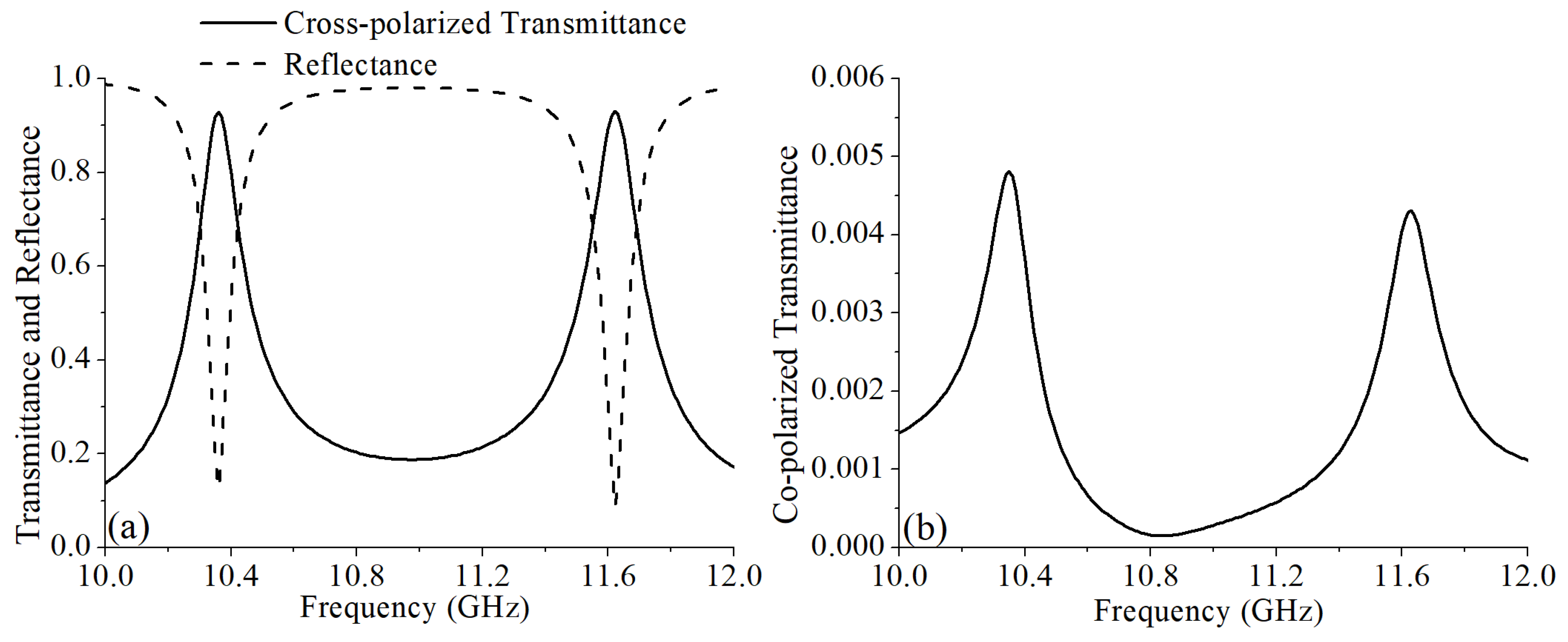
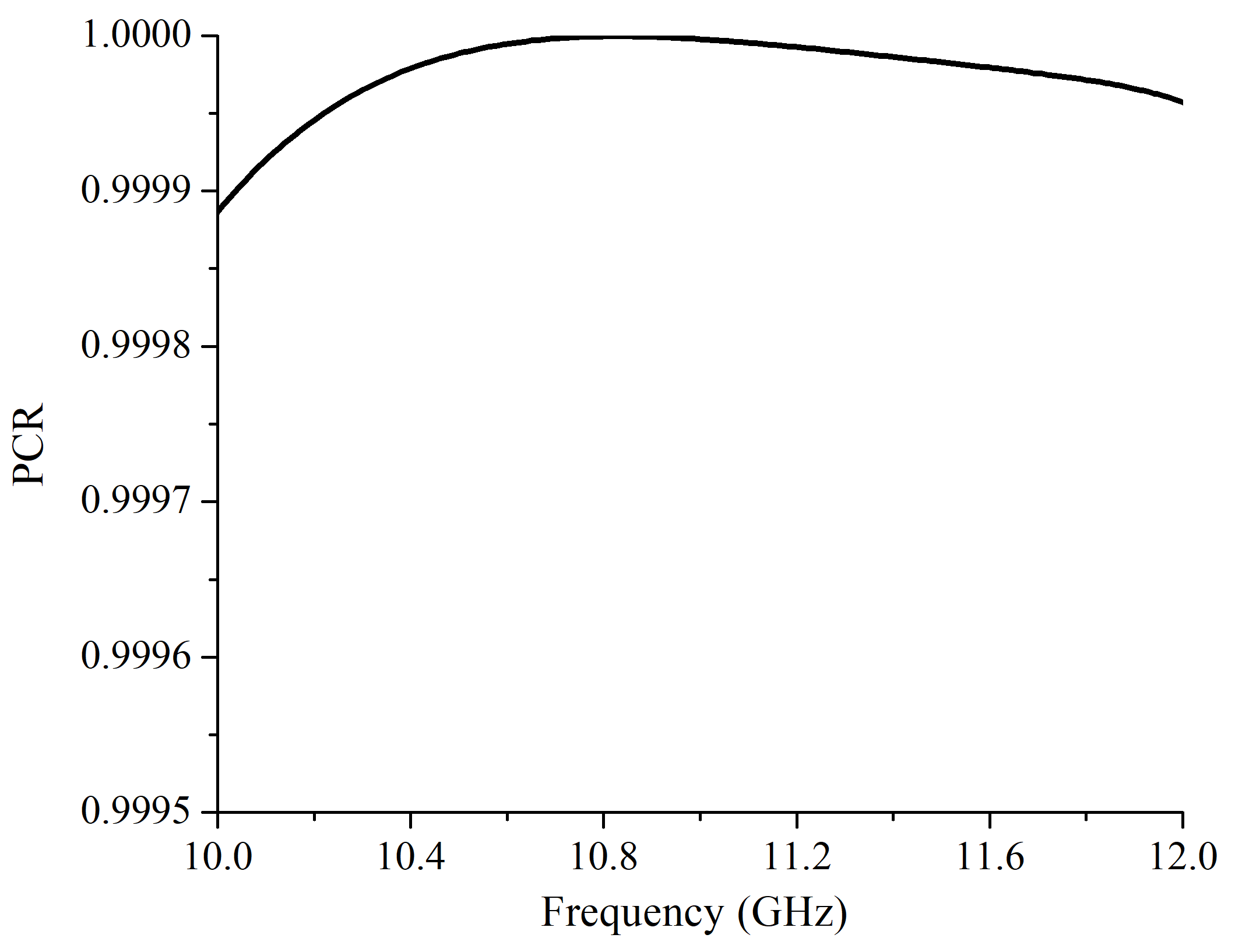
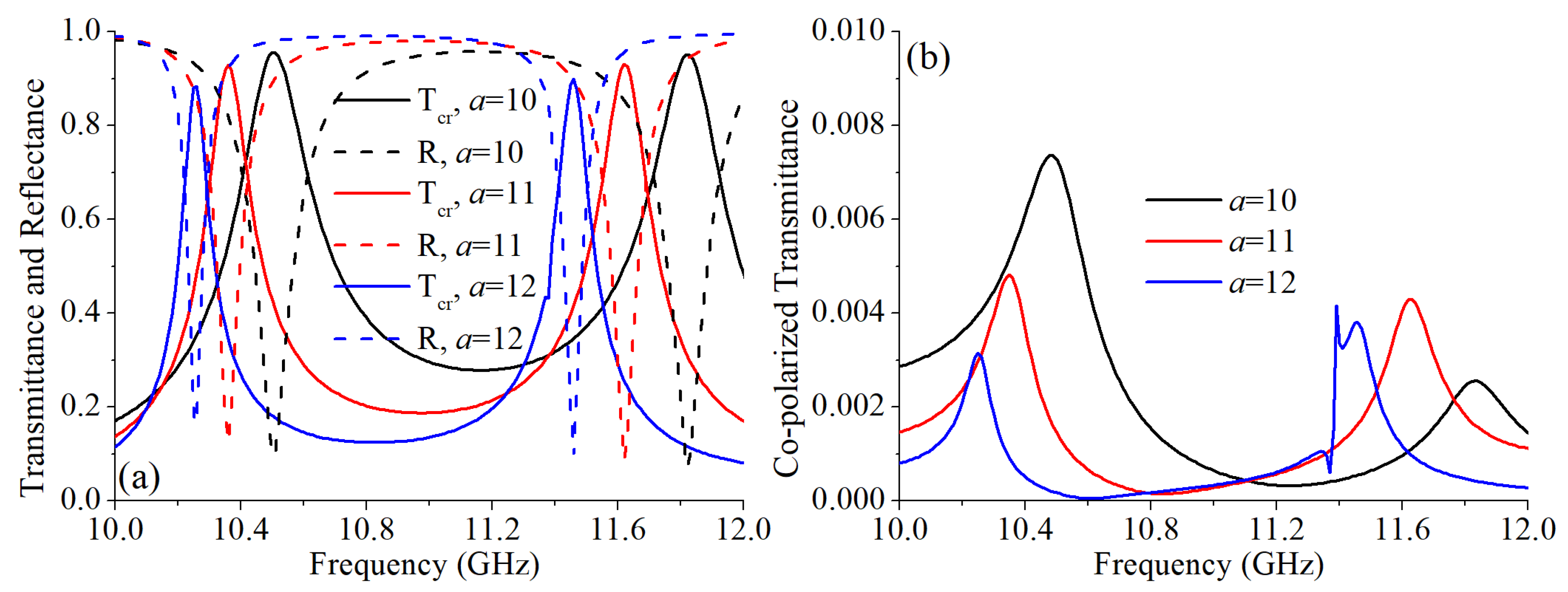

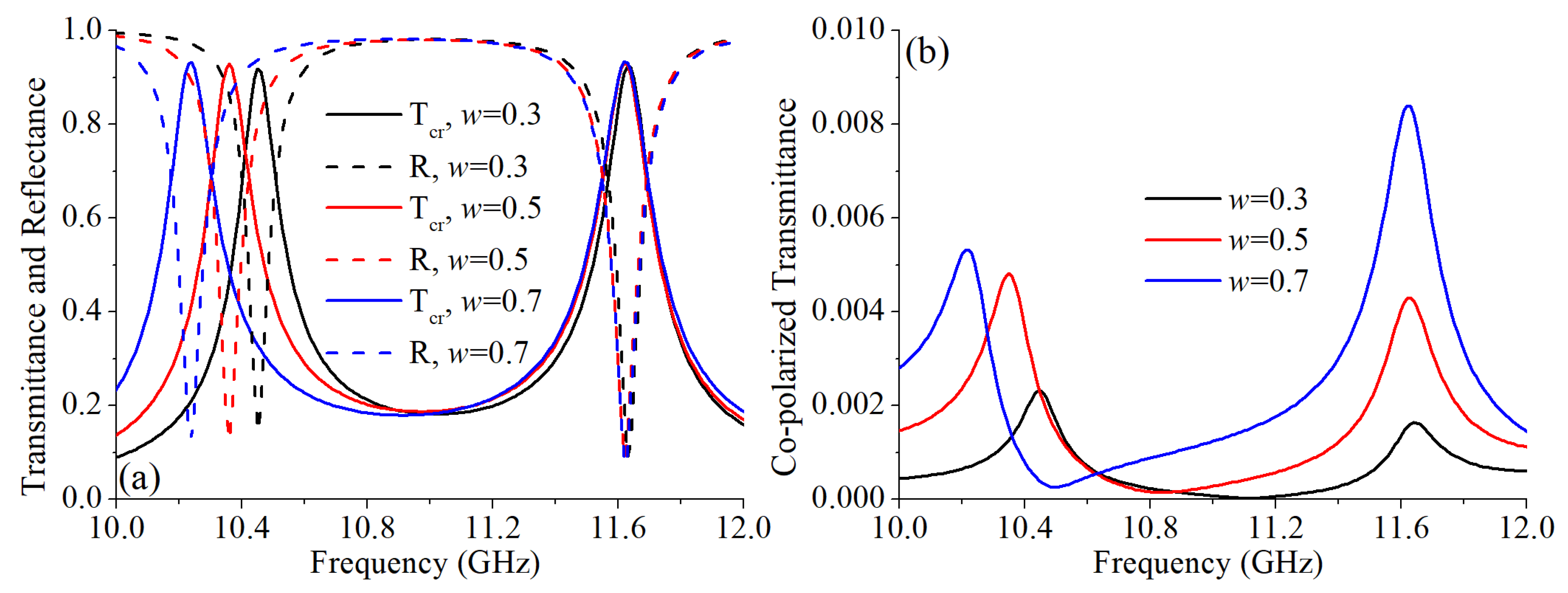
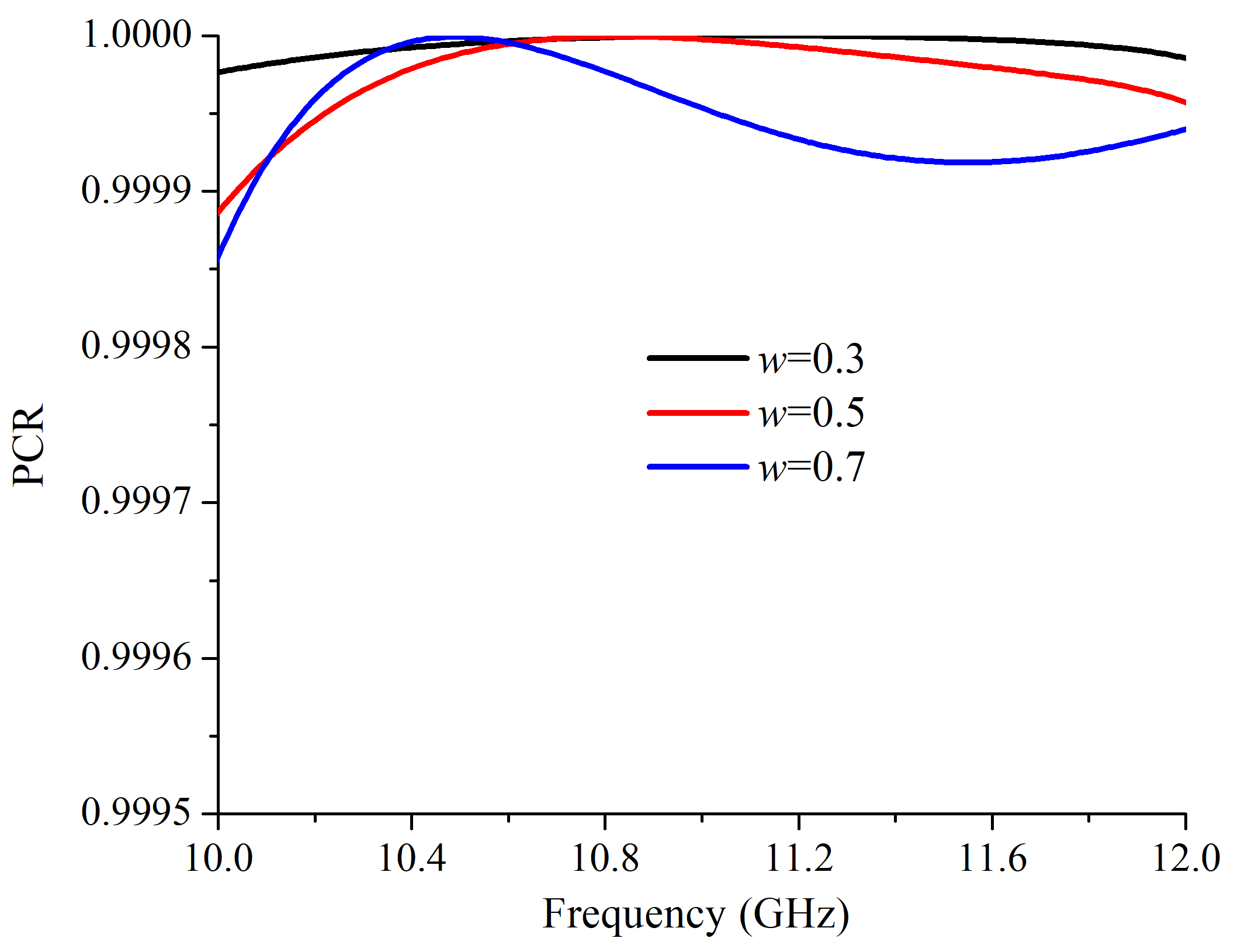
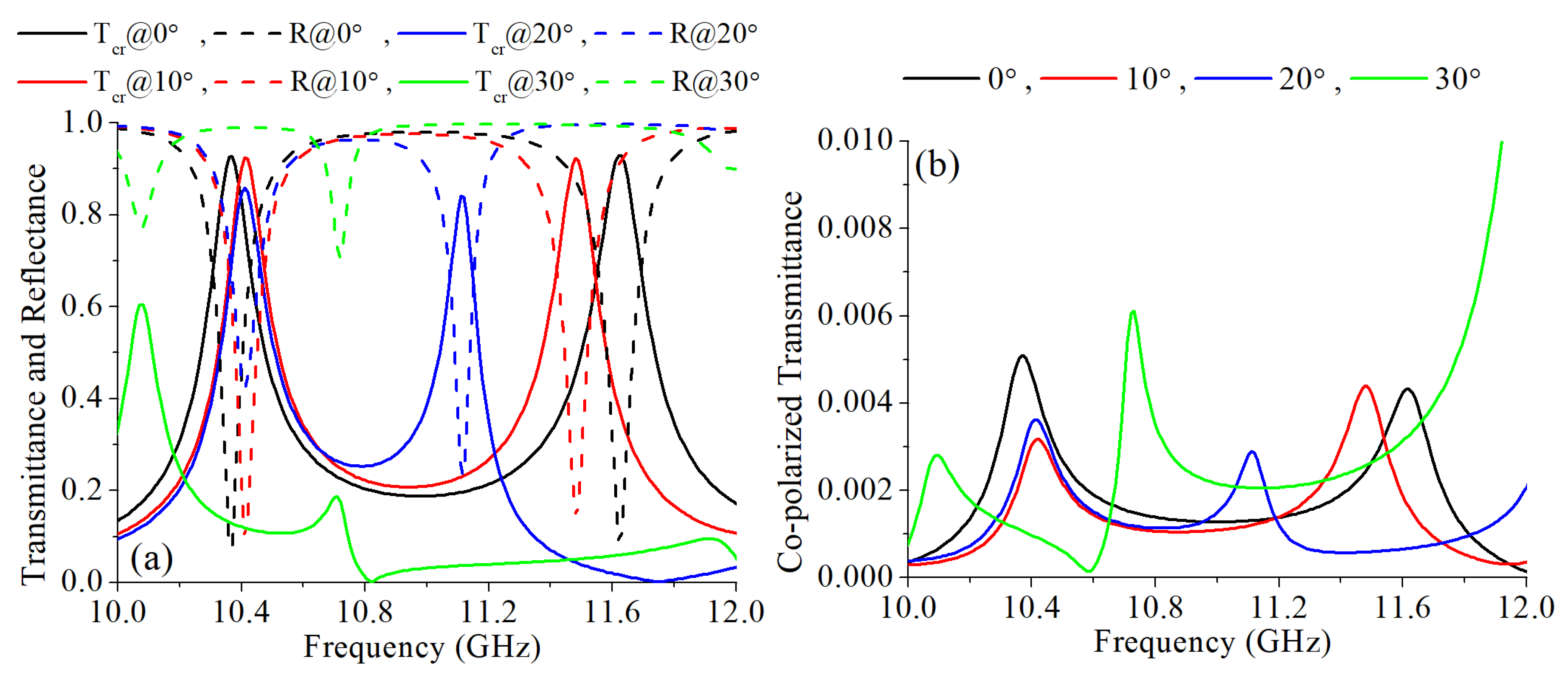


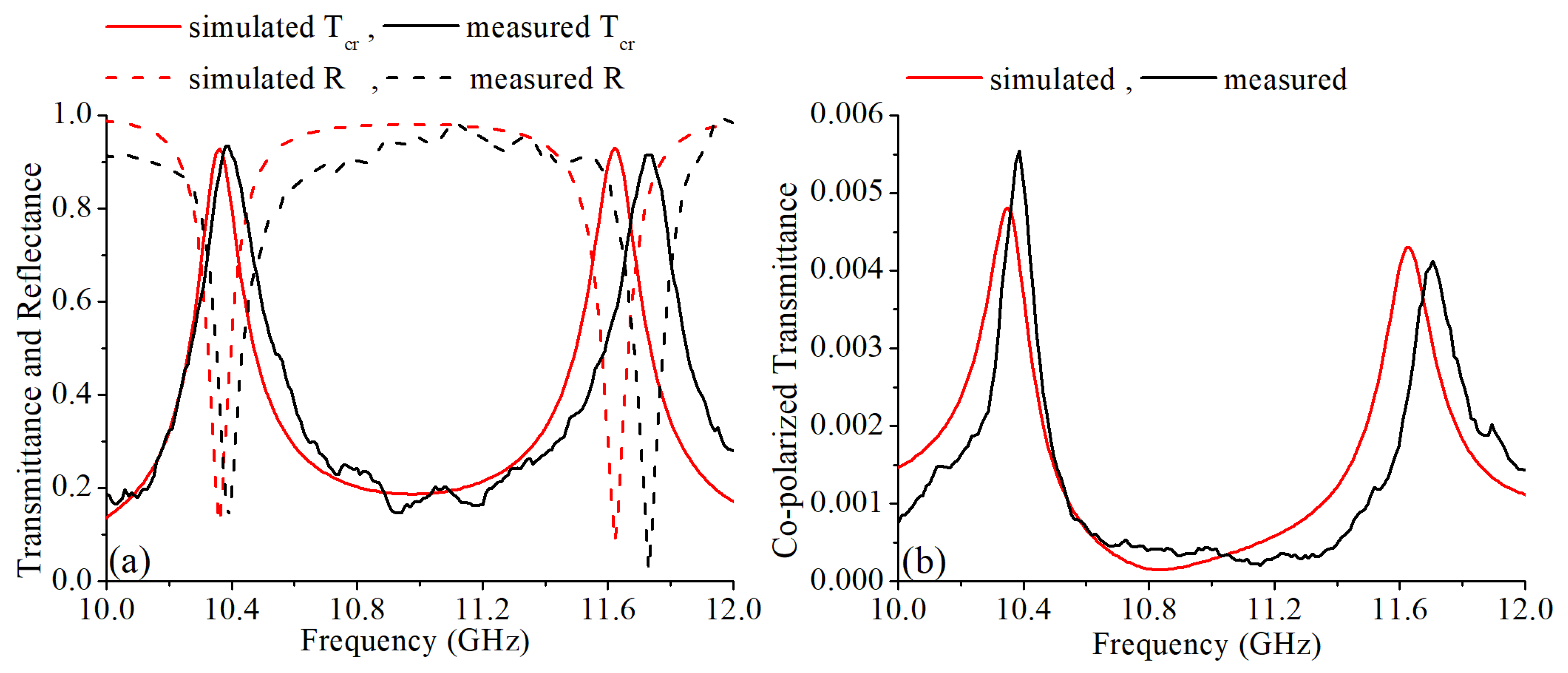
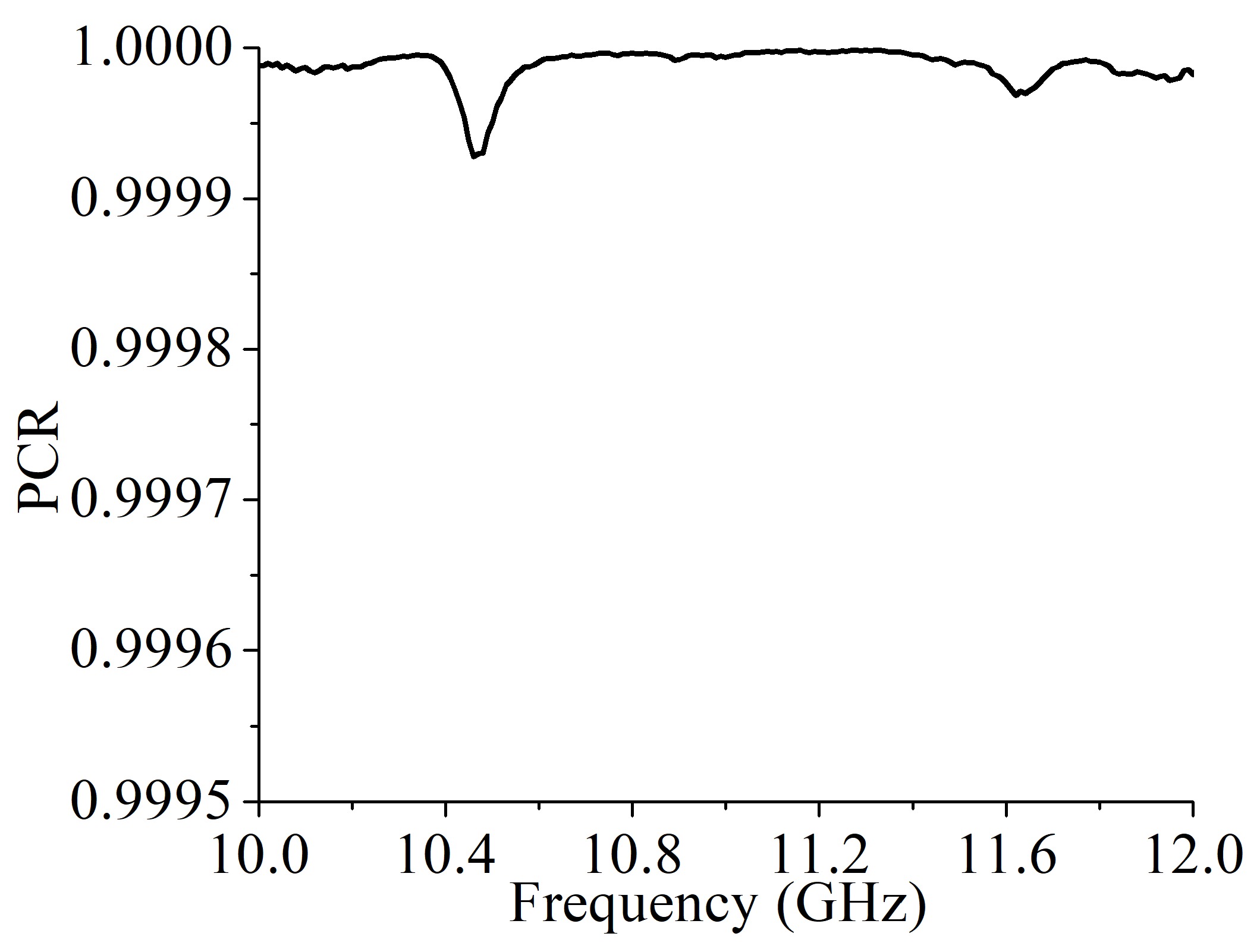
© 2019 by the authors. Licensee MDPI, Basel, Switzerland. This article is an open access article distributed under the terms and conditions of the Creative Commons Attribution (CC BY) license (http://creativecommons.org/licenses/by/4.0/).
Share and Cite
Li, J.; Feng, J.; Li, B.; Shi, H.; Zhang, A.; Chen, J. Dual-Band Transmissive Cross-Polarization Converter with Extremely High Polarization Conversion Ratio Using Transmitarray. Materials 2019, 12, 1827. https://doi.org/10.3390/ma12111827
Li J, Feng J, Li B, Shi H, Zhang A, Chen J. Dual-Band Transmissive Cross-Polarization Converter with Extremely High Polarization Conversion Ratio Using Transmitarray. Materials. 2019; 12(11):1827. https://doi.org/10.3390/ma12111827
Chicago/Turabian StyleLi, Jianxing, Jialin Feng, Bo Li, Hongyu Shi, Anxue Zhang, and Juan Chen. 2019. "Dual-Band Transmissive Cross-Polarization Converter with Extremely High Polarization Conversion Ratio Using Transmitarray" Materials 12, no. 11: 1827. https://doi.org/10.3390/ma12111827




